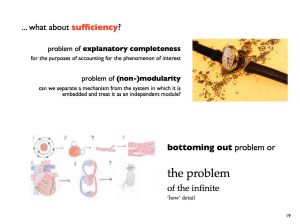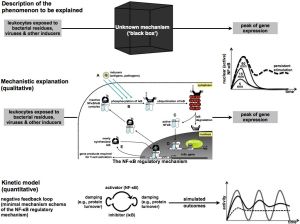Abstract:  According to current accounts, a satisfactory mechanistic explanation should include all the relevant components of the mechanism (entities, activities and organizational features) and exhibit productive continuity from input to output conditions. It is not specified, however, how this kind of ‘mechanistic completeness’ can be demonstrated. Experimental interventions can demonstrate that a mechanism is necessary to produce a phenomenon. Nevertheless, interventions do not demonstrate that a mechanism is sufficient for producing a phenomenon. This creates a cluster of related problems: it is not clear to what extent the explanation is complete, whether the mechanism postulated by the explanation can be detached from the system in which it is embedded and treated as an independent module, and where a mechanistic explanation can safely bottom out.
According to current accounts, a satisfactory mechanistic explanation should include all the relevant components of the mechanism (entities, activities and organizational features) and exhibit productive continuity from input to output conditions. It is not specified, however, how this kind of ‘mechanistic completeness’ can be demonstrated. Experimental interventions can demonstrate that a mechanism is necessary to produce a phenomenon. Nevertheless, interventions do not demonstrate that a mechanism is sufficient for producing a phenomenon. This creates a cluster of related problems: it is not clear to what extent the explanation is complete, whether the mechanism postulated by the explanation can be detached from the system in which it is embedded and treated as an independent module, and where a mechanistic explanation can safely bottom out.
I argue that mathematical modeling of mechanisms can provide a solution to these sufficiency related issues. More and more studies in leading journals complement traditional descriptions of mechanisms supported by the experimental practices of molecular biology with quantitative models aiming to demonstrate that the proposed mechanism can generate the quantitative-dynamic aspects of a phenomena in the right amount/intensity, and thus support the claim that the mechanism is sufficient to produce the phenomenon. While this kind of extrapolative inferences from surrogate mathematical models need to be carefully regimented, they provide a workable solution to the ‘explanatory leakage’ problem whereby it is not clear how systemic a mechanism needs to be and how deep it needs to bottom out in order to explain a phenomenon.


